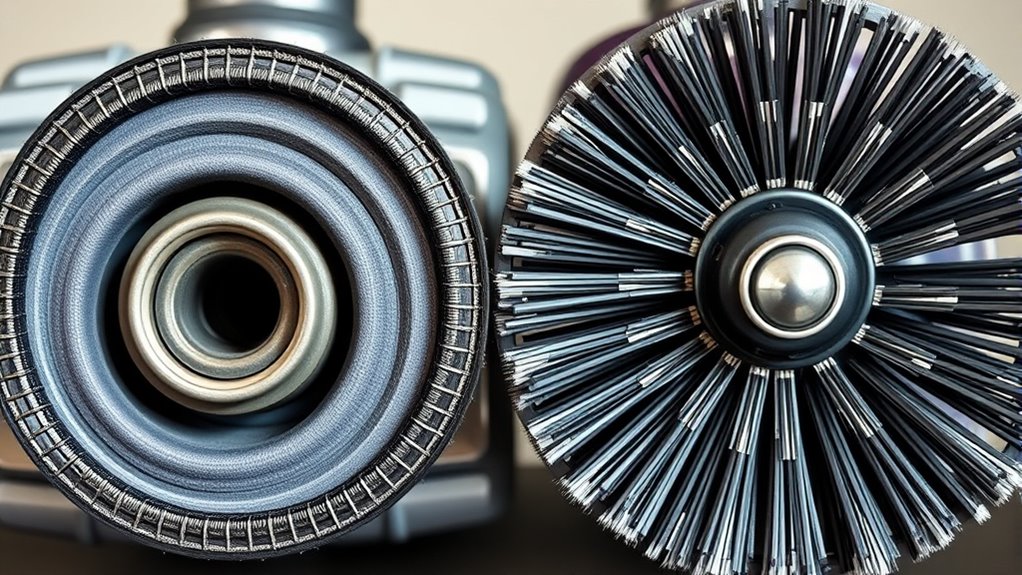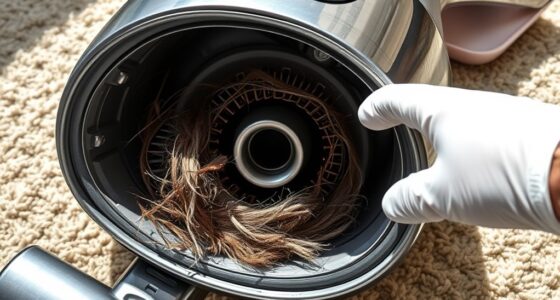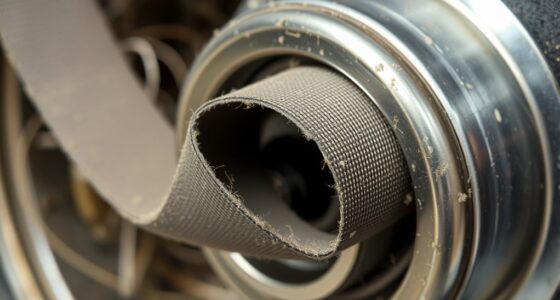Belt-drive vacuum models tend to operate more quietly and require less maintenance since belts absorb vibrations, but they may lose some cleaning power and need belt replacements over time. Direct-drive models connect the motor directly to the brush roll, offering more consistent, powerful cleaning—especially on carpets—though they can be louder and may need more repairs. Understanding these differences helps you choose the best system for your cleaning needs; discover more to make an informed decision.
Key Takeaways
- Direct-drive systems provide more consistent, powerful cleaning due to nearly all motor power reaching the brush roll.
- Belt-drive models operate more quietly as the belt acts as a noise buffer, ideal for noise-sensitive environments.
- Belt-drive vacuums require regular belt replacements, whereas direct-drive units typically need less maintenance.
- Direct-drive models are more effective on dense carpets for deep cleaning, offering superior motor efficiency.
- Belt-drive systems offer quieter operation but may have reduced cleaning power and more frequent belt wear.

When choosing a vacuum cleaner, understanding the differences between belt-drive and direct-drive brush rolls can make a big impact on your cleaning performance. One of the key factors to contemplate is motor efficiency. With belt-drive systems, the motor transfers power to the brush roll via a belt, which can introduce some energy loss. This means that less of the motor’s power reaches the brush, potentially reducing overall cleaning effectiveness on stubborn dirt or carpets. Conversely, direct-drive systems connect the motor directly to the brush roll, ensuring that nearly all the motor’s power is transmitted without loss. As a result, direct-drive models typically deliver more consistent, powerful agitation, making them better suited for deep cleaning. Additionally, the technology used in motor drive systems influences overall performance and durability. Noise levels are another important aspect to consider. Belt-drive vacuum cleaners tend to operate more quietly because the belt acts as a buffer, absorbing some of the vibrations and noise produced by the motor. This can be beneficial if you prefer a quieter cleaning experience or have noise-sensitive household members. However, the noise reduction isn’t always significant, and belt-driven models can still generate considerable sound, especially if the belt slips or wears out over time. On the other hand, direct-drive models often produce louder operation because the motor is directly connected to the brush roll, resulting in more vibrations and noise. If quiet operation is a priority for you, a belt-drive vacuum might be more appealing, but keep in mind that the increased noise from direct-drive units often correlates with their higher power and cleaning efficiency. Durability and maintenance also come into play when comparing these systems. Belt-drive systems require periodic belt replacement, which can be an added maintenance task. Over time, belts may slip or break, leading to decreased performance until replaced. Direct-drive systems generally require less maintenance since there are no belts involved, but the motor itself can be more complex and potentially more costly to repair if it fails. Ultimately, the choice between belt-drive and direct-drive brush rolls hinges on what you value most. If you prioritize quieter operation and lower maintenance, a belt-drive model might suit you best. If you want maximum cleaning power and efficiency, especially on dense carpets, a direct-drive vacuum offers superior motor efficiency and more consistent results. Understanding these differences helps you select a vacuum that aligns with your cleaning needs and preferences, ensuring a more satisfying experience every time you clean.
Frequently Asked Questions
Which Type Requires Less Maintenance Over Time?
You’ll find that direct-drive brush rolls generally require less maintenance over time. They have better belt longevity because they don’t rely on belts that can wear out or break. Plus, with fewer moving parts, there’s less motor wear, reducing the need for repairs. This means your vacuum stays in good shape longer, saving you time and money on maintenance. Overall, direct-drive systems tend to be more durable and reliable.
Are Belt-Drive Models More Affordable Than Direct-Drive Ones?
Belt-drive models generally cost less than direct-drive ones, making them a more budget-friendly choice. For a better cost comparison, you’ll find more affordable options across various brand options with belt-drive vacuums. However, keep in mind that direct-drive models often offer longer-lasting performance and less maintenance. If budget is your main concern, you’ll likely find belt-drive options more accessible and affordable within your preferred brands.
How Does Noise Level Compare Between the Two?
When comparing noise levels, you’ll find that direct-drive vacuum cleaners generally operate quieter than belt-drive models. The sound levels of direct-drive models tend to be lower because they have fewer moving parts and less vibration, reducing noise during operation. Belt-drive machines may produce more noise due to the belt’s movement and tension. So, if noise comparison is important to you, a direct-drive vacuum might be the quieter choice.
Can Either System Be Easily Replaced or Upgraded?
Imagine giving your vacuum new life — that’s the beauty of replacement ease and upgrade compatibility. Both belt-drive and direct-drive systems can often be swapped out or upgraded with some effort, but belt drives might require more patience due to their complexity. With careful handling, you can rejuvenate your machine, ensuring it continues to serve you well. Your choice depends on how much you’re willing to invest in maintenance and upgrades.
Do Different Floor Types Influence the Choice Between Belt and Direct Drive?
You should consider your floor texture and cleaning effectiveness when choosing between belt and direct drive. For textured carpets or uneven surfaces, a direct-drive system offers consistent power, improving cleaning. Smooth floors may benefit from belt-drive’s gentle operation. Think about how each system handles your specific floor type to guarantee peak cleaning efficacy. Your choice impacts how well your vacuum tackles dirt and debris across different surfaces.
Conclusion
Ultimately, choosing between belt-drive and direct-drive brush rolls depends on your cleaning needs. If you want a quieter, low-maintenance option, direct-drive might be your best bet. However, if you prefer a more forgiving, budget-friendly choice, belt-drive could serve you well. Remember, sometimes you get what you pay for, but no matter which you pick, regular maintenance guarantees your vacuum performs at its best. The key is to weigh the pros and cons carefully and make an informed decision.









